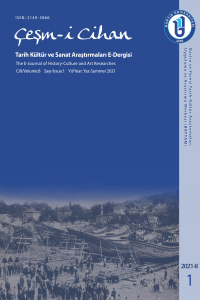Öz
Religion has influenced the art thought and activities of almost every society and civilization both in the past and today. Although religion influenced art, religion was not the only determinant of every artistic creation that occurred in history. From the emergence of Islamic art to the Muslim artist's attitude towards art/ artist, many subjects have been directly associated with religion by various schools or scholars, and many historical, economic or political backgrounds have been ignored. The concept of "sacred art" is one of the conceptualizations that has been heated debate since the early 20th century. The concept seems problematic both in terms of Islam and art history. The first reason for this is the way Islam defines the sacred, the second is the difficulty of reading the religious, socio-political and cultural elements in which Islamic arts developed together with the concept of "sacred". The understanding sacred of Islam makes it questionable to talk about the existence of sacred art with the same precision as in other beliefs.What is sacred in terms of Islam is evident in verses. If there is a sacred art of Islam/or sacred İslamic architecture, the first place where it appears should be the Masjid an-Nabawi in Medina because this mosque was made by the prophet of Islam himself. Many writers who wrote on Islamic arts, particularly, members of the traditionalist school tried to base their "Sacred Art" discourse not on the Masjid an-Nabawi but on the architectural structures that emerged after it. When we look at the general architectural form of the Masjid an-Nabawi, the building elements and techniques used, verses of the Qur'an and the narratives, there is no information that the prophet was given a holy guidance in the process of building the mosque. It is seen that the construction style of the mosque is based on the building knowledge and culture in Medina of the time. Even the Kaaba, which is seen as sacred for the Quran, has no role in shaping the architectural form of the Masjid an-Nabawi. The construction process of the Masjid an-Nabi and the changes in the architectural understanding here until the death of the Prophet clearly show us that the definition of "sacred art" cannot be made for Islamic arts, especially Islamic architecture.
Anahtar Kelimeler
Kaynakça
- Burckhardt, Titus. Doğuda ve Batıda Kutsal Sanat: Sanatın İlkeleri Ve Yöntemleri. çev. Tahir Uluç. İstanbul: İnsan Yayınları, 2017.
Öz
Din hemen her toplum ve medeniyetin sanatsal düşünce ve faaliyetlerini hem geçmişte hem de günümüzde etkilemiştir ve etkilemektedir. Din, sanatı her ne kadar etkilemiş olsa da tarihte meydana gelmiş her sanatsal yaratımın tek belirleyicisi din olmamıştır. İslam sanatının ortaya çıkışından Müslüman sanatçının sanat/ sanat eseri karşısında tavır alışına kadar birçok konu çeşitli ekoller veya ilim adamları tarafından doğrudan dinle ilişkilendirilmiş fakat birçok tarihi, ekonomik veya siyasal arka plan görmezden gelinmiştir. “Kutsal sanat” kavramı 20. yüzyılın başlarından itibaren hararetli bir şekilde konuşulan kavramsallaştırmalardan biridir. Kavram hem İslam hem de sanat tarihi anlamında sorunlu görünmektedir. Bunun birinci nedeni İslam’ın kutsalı tanımlama şekli, ikincisi ise İslami sanatların içinde geliştiği dini, sosyo-politik ve kültürel unsurların “kutsal” kavramı ile birlikte okunmasının zorluğudur. İslam’ın kutsal anlayışı diğer inanışlarda olduğu gibi aynı kesinlikte kutsal sanatın varlığından söz etmeyi tartışmalı hale getirmektedir. İslam açısından neyin kutsal olduğu ayetlerle sabittir. İslam’ın bir kutsal sanatı varsa bunun ortaya çıkacağı ilk yer Medine’deki Mescid-i Nebevi olmak durumundadır çünkü bu mescit bizzat İslam peygamberi tarafından yapılmıştır. Başta gelenekselci ekol mensupları olmak üzere İslami sanatlar üzerine yazan birçok yazar “kutsal sanat” söylemlerini Mescid-i Nebevi üzerinden değil de ondan sonra ortaya çıkan mimari yapılar üzerinden temellendirmeye çalışmışlardır. Mescid-i Nebevî'nin mimari özelliklerinin yanı sıra Kur’an ayetlerine ve hadis rivayetlere baktığımızda, yapım sürecinde Peygamber’e kutsal bir rehberlik edildiğine dair hiçbir bilgi yoktur. Mescidin inşa şeklinin zamanın Medine’sindeki yapı bilgilerine ve kültürüne dayandığı görülmektedir. Hatta Kuran için kutsal olarak görülen Kâbe’nin bile Mescid-i Nebevi’nin mimari formunun şekillenmesinde bir rolü yoktur. Mescid-i Nebevi’nin yapım süreci ve Peygamberin vefatına kadar burada mimari anlamada meydana gelen değişiklikler ve olaylar başta İslami mimari olmak üzere İslami sanatlar için “kutsal sanat” nitelemesinin yapılamayacağını bize açık bir şekilde göstermektedir.
Anahtar Kelimeler
Kaynakça
- Burckhardt, Titus. Doğuda ve Batıda Kutsal Sanat: Sanatın İlkeleri Ve Yöntemleri. çev. Tahir Uluç. İstanbul: İnsan Yayınları, 2017.
Ayrıntılar
| Birincil Dil | Türkçe |
|---|---|
| Bölüm | Makaleler |
| Yazarlar | |
| Yayımlanma Tarihi | 27 Haziran 2021 |
| Gönderilme Tarihi | 10 Nisan 2021 |
| Yayımlandığı Sayı | Yıl 2021 Cilt: 8 Sayı: 1 |
Cited By
Keşif ve Merakın İzinde: Richard Francis Burton’un Mescid-i Nebevî Macerası
Abant Sosyal Bilimler Dergisi
https://doi.org/10.11616/asbi.1516315

Çeşm-i Cihan: Tarih Kültür ve Sanat Araştırmaları E-Dergisi Creative Commons Atıf-GayriTicari 4.0 Uluslararası Lisansı ile lisanslanmıştır.
Dergimiz aşağıdaki indeksler tarafından taranmaktadır:




